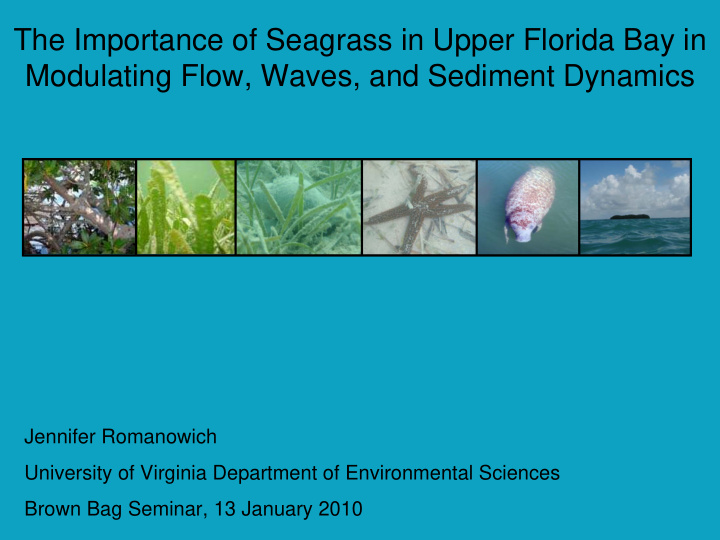



The Importance of Seagrass in Upper Florida Bay in Modulating Flow, Waves, and Sediment Dynamics Jennifer Romanowich University of Virginia Department of Environmental Sciences Brown Bag Seminar, 13 January 2010
Everglades and Florida Bay: • Everglades: – 50% human population of Florida – Loss of 50% of wetlands and 90% of bird population • Florida Bay: – Seagrass support entire food chain – Naturally variable and currently vulnerable Everglades National Park Everglades National Park Florida Bay Florida Bay
Connectivity: • 11,000 mi 2 area of connected flow • Everglades buffered storms and floods • Drainage to Florida Bay – Salinity impact From Everglades Foundation From Villy Kourafalo SoFLA-HYCOM
Seagrass Ecosystem: • Die-offs: – Drought salinity 60% greater – Sulfide toxicity and hypoxia – Slime mold – Boat scarring Jennifer Romanowich Photo from: University of Georgia Biological Oceanography Modeling Lab • Distribution depends on: – Water depth/light – Nutrient availability and Open Mud delivery Sparse Seagrass – Salinity Intermediate Seagrass Dense Seagrass – Water clarity
Restoration Efforts: http://www.evergladesplan.org/pub/restudy_eis.aspx • Everglades: – New levee and drainage canal – Remove sections of Tamiami Trail – Widen spatial distribution of flow • Improve quantity, quality, timing and distribution of flow • Understand flow interactions with seagrass and sediment dynamics • Determine storm effects on seagrass beds
Site Description: • Florida Bay Seagrass Meadows: – Depth: 3-4m – Tidal range: 0.1-0.3m – Seagrass species: Thalassia testudinum From Everglades National Park web site
Instrument Deployment:
cm/s Instrument Deployment:
Results: Bottle Bare upper Bottle Bare lower Bottle Grass • Seagrass disrupts • Highest flow at Rabbit Rabbit boundary layer • Sediment high at bare and • Enhanced mixing with wind Rabbit even with high density Days from Jan 2009 Bottle Seagrass Rabbit Seagrass Bottle Bare Bottle Seagrass Rabbit Seagrass Rabbit Seagrass upper lower Days from Jan 2009 Days from Jan 2009 cm/s cm/s cm/s cm/s
Summary: • Seagrass slow flow near bed • Waves in Florida bay increase sediment suspension • Small scale velocity patterns suggest enhanced mixing in meadows • Bulk water from Everglades may be mixed into seagrass meadow
Acknowledgements: Funding: – Florida Everglades Foundation Fellowship – National Science Foundation Biological Oceanography Graduate Research Fellowship
Recommend
More recommend